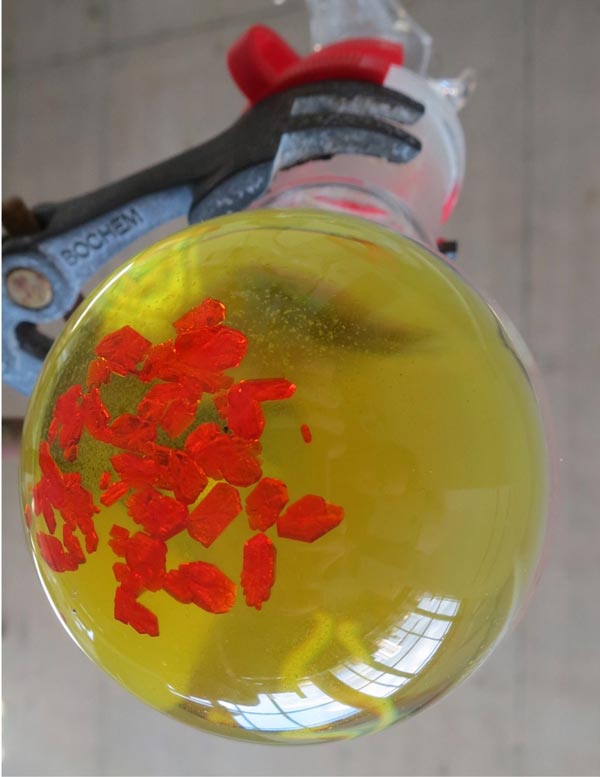Scientists develop molecular thermometer for contactless measurement using infrared light

The molecular ruby in a solid (red) and dissolved (yellow) state can be used for contactless measurement of temperature. photo/©: Sven Otto, JGU
Chemists at Johannes Gutenberg University Mainz (JGU) in cooperation with researchers of the German Federal Institute for Materials Research and Testing (BAM) in Berlin have developed a molecular thermometer. The gemstone ruby served as the source of inspiration.
However, the thermometer developed by the team headed by Professor Katja Heinze at the JGU Institute of Inorganic Chemistry and Analytical Chemistry is a water-soluble molecule, not an insoluble solid. Like a ruby, this molecule contains the element chromium that gives it its red color, which is why it has also been dubbed the molecular ruby.
This molecular ruby can be used to measure temperature in many different environments thanks to its solubility: it can be introduced into liquids, solids, nano-particles, and micelles. Thus, it has potential applications in the fields of the material sciences, biology, and medicine.
Measuring the temperature with the molecular ruby is very straightforward. The relevant site is irradiated with blue light, which is absorbed by the molecular ruby that then emits infrared radiation at two different wavelengths. Depending on the temperature, there is more intense emission of infrared at one of the two wavelengths. The temperature is then determined on the basis of the corresponding ratio of intensity of the two wavelengths.
“Anyone with a simple emission spectrometer can undertake this kind of measurement,” explained Sven Otto, a doctoral candidate in Heinze's team. “The molecular ruby works at 100 degrees Celsius just as well as at minus 63 degrees Celsius, that is in a range relevant to everyday practice,” added Otto.
The principle of optical ratiometric temperature measurement is not new. However, it was previously impossible to take measurements using only a single type of photoactive agent. To date, scientists always needed two dyes, i.e., one that produced emission dependent on temperature and another reference dye with emission independent of temperature. That made synthesis and calibration a lot more difficult.
“Our molecular ruby, on the other hand, is simply made from inexpensive raw materials and no additional reference substances are required to measure temperature,” said Professor Katja Heinze. “It can be employed whenever we want to measure temperature without having to contact the object directly as with a conventional thermometer.”
The research findings have been published in a special edition of Chemistry – A European Journal designed to mark the 150th anniversary of the German Chemical Society (GDCh) and featuring contributions from eminent German researchers.
The research work is being funded by the German Research Foundation (DFG) within the framework of, inter alia, the Graduate School of Excellence Materials Science in Mainz (MAINZ). The DFG recently approved a new priority program entitled “Light-controlled reactivity of metal complexes” that is coordinated by Professor Katja Heinze.
Photo:
http://www.uni-mainz.de/bilder_presse/09_anorgchemie_rubin_thermometer.jpg
The molecular ruby in a solid (red) and dissolved (yellow) state can be used for contactless measurement of temperature.
photo/©: Sven Otto, JGU
Publications:
Sven Otto et al.
Thermo-Chromium: A Contactless Optical Molecular Thermometer
Chemistry – A European Journal, 15 May 2017
DOI: 10.1002/chem.201701726
http://onlinelibrary.wiley.com/doi/10.1002/chem.201701726/abstract
http://onlinelibrary.wiley.com/journal/10.1002/(ISSN)1521-3765/homepage/2111_gdc…
Sven Otto et al.
[Cr(ddpd)2]3+: A Molecular, Water-Soluble, Highly NIR-Emissive Ruby Analogue
Angewandte Chemie International Edition, 12 August 2015
DOI: 10.1002/anie.201504894
http://onlinelibrary.wiley.com/doi/10.1002/anie.201504894/abstract
Contact and further information:
Professor Dr. Katja Heinze
Institute of Inorganic Chemistry and Analytical Chemistry
Johannes Gutenberg University Mainz
55099 Mainz, GERMANY
phone +49 6131 39-25886
fax +49 6131 39-27277
e-mail: katja.heinze@uni-mainz.de
https://www.ak-heinze.chemie.uni-mainz.de/
http://www.bundesgraduiertenschule-gruppe-mainz.uni-mainz.de/ – Graduate School of Excellence Materials Science in Mainz ;
http://www.uni-mainz.de/presse/aktuell/1212_ENG_HTML.php – press release “Johannes Gutenberg University Mainz to coordinate new DFG priority program in photochemistry”, 25 April 2017 ;
http://www.uni-mainz.de/presse/17824_ENG_HTML.php – press release “Katja Heinze receives research award for intelligent food packaging with freshness indicator”, 5 December 2014
Media Contact
All latest news from the category: Life Sciences and Chemistry
Articles and reports from the Life Sciences and chemistry area deal with applied and basic research into modern biology, chemistry and human medicine.
Valuable information can be found on a range of life sciences fields including bacteriology, biochemistry, bionics, bioinformatics, biophysics, biotechnology, genetics, geobotany, human biology, marine biology, microbiology, molecular biology, cellular biology, zoology, bioinorganic chemistry, microchemistry and environmental chemistry.
Newest articles

A ‘language’ for ML models to predict nanopore properties
A large number of 2D materials like graphene can have nanopores – small holes formed by missing atoms through which foreign substances can pass. The properties of these nanopores dictate many…

Clinically validated, wearable ultrasound patch
… for continuous blood pressure monitoring. A team of researchers at the University of California San Diego has developed a new and improved wearable ultrasound patch for continuous and noninvasive…

A new puzzle piece for string theory research
Dr. Ksenia Fedosova from the Cluster of Excellence Mathematics Münster, along with an international research team, has proven a conjecture in string theory that physicists had proposed regarding certain equations….



